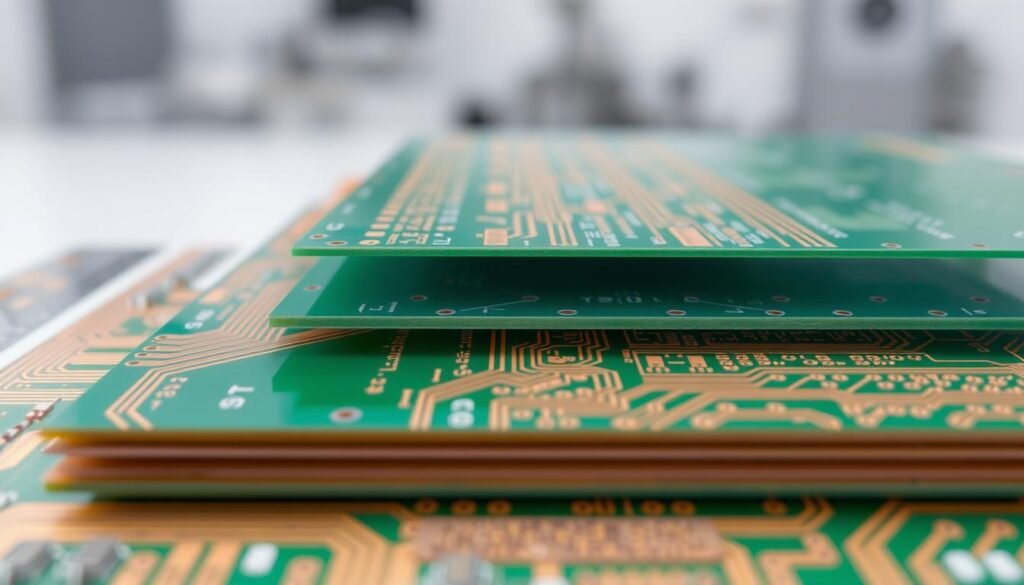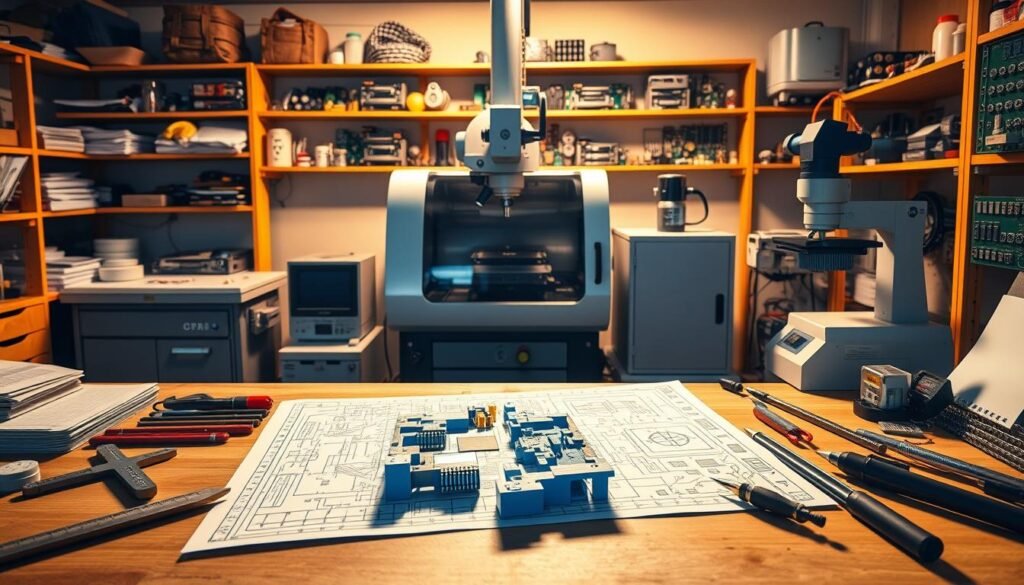What if the price you pay for electronics manufacturing isn’t as straightforward as it seems? Many procurement teams assume quotes reflect only materials and labor, but hidden variables often create confusion. Understanding what drives expenses in printed circuit board production can mean the difference between overspending and achieving true value.
We break down three core elements shaping project budgets. Fabrication covers raw board creation, while assembly involves component placement and soldering. Engineering costs—like design validation and testing setups—form the third pillar. These layers interact dynamically, influenced by design complexity and order volumes.
The global market for these components is projected to reach $118.63 billion by 2031, according to Kings Research. With such growth, manufacturers must prioritize cost clarity. Transparent pricing models empower teams to compare vendors effectively and negotiate smarter contracts.
We explore how material choices, testing protocols, and geographic factors impact final numbers. By demystifying industry practices, this guide helps technical buyers build resilient partnerships while maintaining quality benchmarks. Let’s uncover what truly defines value in electronics production.
Key Takeaways
- Total expenses split into fabrication, assembly, and one-time engineering fees
- Design complexity and order volume directly affect pricing tiers
- Global market expansion intensifies need for cost optimization strategies
- Transparent breakdowns enable accurate vendor comparisons
- Material selection and testing requirements influence final quotes
Understanding PCB and PCBA Pricing Fundamentals
Navigating electronics pricing starts with decoding the blueprint of production expenses. Every device relies on printed circuit boards—layered structures that power functionality through precise electrical pathways. We dissect the elements shaping these critical components and their financial implications.
Definition and Core Components
Printed circuit boards consist of non-conductive base materials like FR-4 or resin composites layered with copper traces. These substrates form the foundation for mounting surface-mount devices or through-hole components. Structural complexity directly affects costs:
| Layer Type | Typical Use Cases | Cost Impact |
|---|---|---|
| Single-Layer | Basic consumer electronics | Lowest |
| Double-Layer | Automotive sensors | +30-50% |
| Multi-Layer | Medical devices, aerospace | +70-200% |
Material selection determines thermal stability and signal integrity. High-frequency applications often require specialized substrates, adding 15-25% to base pricing compared to standard FR-4 boards.
The Role of Quality and Transparency in Pricing
Manufacturers adhering to IPC-A-610 standards typically show 20% fewer defects in final products. We prioritize open cost breakdowns that specify:
- Material grades and sourcing origins
- Testing protocols (AOI vs. X-ray)
- Labor hours per assembly stage
This clarity prevents budget surprises while aligning technical specs with financial plans. Transparent partners often provide lifecycle cost projections, enabling smarter procurement decisions across product generations.
Key Factors Influencing PCB Fabrication Costs

Complexity drives expenses in circuit board production. Multiple technical variables interact to determine final pricing—understanding these levers helps teams prioritize critical specifications while managing budgets.
Material Types, Layer Counts, and Board Sizes
Layer quantity remains the primary cost multiplier. Single-layer designs require basic lamination, while 8-layer boards demand precise alignment of conductive pathways. Each added layer increases drilling time by 15% and material waste by 12%.
Standard FR-4 substrates handle most applications at $2-$5 per square foot. High-frequency designs often need Rogers materials costing $10-$25 per square foot. Flexible polyimide boards add 40-60% to baseline pricing due to specialized handling requirements.
Board dimensions directly affect raw material consumption. A 12×16-inch panel uses 30% more copper than an 8×10-inch version. Larger sizes also reduce panels-per-sheet efficiency during manufacturing.
Surface Finish, Copper Thickness, and Design Complexity
Protective coatings impact both performance and cost. HASL finishes cost $0.05 per board but struggle with fine-pitch components. ENIG coatings provide superior solderability at $0.20-$0.50 per unit—ideal for dense layouts.
Copper weight variations alter processing timelines. While 1oz copper works for most signals, 3oz layers require extended etching cycles. Power-intensive designs using heavy copper see 25-40% longer fabrication schedules.
Advanced features like blind vias or impedance-controlled traces demand specialized equipment. These requirements often double testing time compared to standard through-hole designs.
Detailed Insights into PCB Assembly Costs
Assembly processes shape budgets as much as design choices in electronics manufacturing. While automated systems drive efficiency, human expertise remains critical for quality outcomes. We dissect the variables determining final expenses from component placement to final inspection.
Assembly Methods and Labor Considerations
Surface mount technology (SMT) dominates modern production with 80% faster placement rates than through-hole methods. Automated pick-and-place machines handle 25,000 components per hour, slashing labor needs. However, mixed assemblies requiring both SMT and manual through-hole work increase costs by 35-50%.
| Method | Speed | Labor Impact | Cost Per Unit |
|---|---|---|---|
| SMT Only | High | Low | $0.15-$0.40 |
| Mixed Assembly | Medium | High | $0.55-$1.20 |
| Through-Hole Only | Low | Very High | $1.50-$3.00 |
Complex designs requiring hand-soldering or microscope-assisted assembly triple technician hours compared to standard boards. Quality control processes add 15-20% to labor costs but reduce field failures by 40%.
Component Sourcing and Machine Setup Implications
Procurement strategies directly affect timelines and budgets. Manufacturers offering component sourcing services typically charge 10-25% markup but guarantee supply chain validation. Client-supplied parts shift inventory risks but require extended lead time coordination.
- Setup fees for SMT lines range $150-$500 per project
- Stencil costs increase 30% for boards exceeding 20 components
- Changeovers between product variants add 2-4 hours downtime
“The 2023 semiconductor shortage increased average assembly costs by 18% for automotive clients,” notes a recent IPC industry report.
Low-volume runs under 100 units face 60% higher per-board costs than 1,000-unit orders. This pricing dynamic makes prototype batches ideal for design validation before scaling production.
Engineering and Tooling Costs: Hidden Expenses Explained

Behind every functional circuit board lies a maze of preparatory work that shapes budgets. While visible expenses grab attention, engineering investments determine long-term viability. We unpack these critical yet frequently underestimated factors.
Initial Design and DFM File Checks
Design for Manufacturing (DFM) reviews prevent costly mid-production changes. Our teams analyze 25+ parameters, from trace spacing to component clearances. Projects skipping this step face 43% higher revision fees, according to IPC benchmarks.
Key review phases include:
- Material compatibility assessments
- Thermal expansion simulations
- Solder mask alignment tolerances
One-Time Tooling, Testing, and Inspection Fees
Custom fixtures and protocols ensure quality but demand upfront investments. A basic solder paste stencil costs $80-$200, while functional test rigs range $1,500-$5,000. These tools become economical across multiple batches.
| Order Size | Per-Unit Tooling Cost | Testing Fee Impact |
|---|---|---|
| 50 units | $12.40 | +38% |
| 500 units | $1.85 | +6% |
| 5,000 units | $0.22 | +0.9% |
Automated optical inspection setups add $0.08-$0.15 per board but slash defect rates by 60%. Strategic partners amortize these one-time fees through multi-project agreements, maximizing value for prototype-stage clients.
How PCBA Costs Are Calculated: A Buyer’s Guide to Transparent Pricing
Modern estimation platforms transform how teams forecast electronics production budgets. These systems analyze design specifications against real-time supplier data, delivering instant price transparency. We walk through practical applications of these digital tools.
Utilizing Cost Estimators and Online Calculators
Leading platforms like PCBasic’s calculator require four key inputs:
- Board dimensions and layer configuration
- Material type and surface finish preferences
- Copper weight and quantity requirements
- Turnaround time specifications
Automated systems process these parameters against current material market rates and machine capacity data. For standard 4-layer boards, these tools achieve 92% accuracy compared to final invoices according to 2023 industry benchmarks.
Interpreting the Breakdown of Each Expense
Comprehensive quotes separate fabrication (35-60% of total), assembly (25-50%), and engineering costs. This visibility helps identify optimization opportunities:
| Cost Driver | Automated Quote | Manual Review |
|---|---|---|
| Complex Routing | +15% Estimate | +22% Actual |
| Exotic Materials | Fixed Markup | Market-Adjusted |
| Microvia Designs | Not Detected | +18% Fee |
While instant calculators suit simple projects, designs with blind vias or impedance controls benefit from human analysis. Our teams cross-reference 14 manufacturing variables during manual reviews to prevent budget surprises.
Volume discounts typically activate at 500+ units for standard circuit boards, reducing per-unit costs by 40-60%. Use automated tools for initial budget planning, then request detailed quotes when finalizing designs.
Practical Strategies for Optimizing PCB Costs
Smart design choices unlock hidden savings in electronics production. We implement proven techniques that balance technical requirements with budget realities, focusing on three core optimization pillars.
Design Optimization and Standard Specification Use
Simplified layouts reduce manufacturing complexity. Our teams achieve 18-35% cost reductions by:
- Limiting layers to essential signal paths
- Using standard 1.6mm board thickness
- Selecting HASL finishes over specialty coatings
Complex designs with 8+ layers cost 2.7x more than 4-layer alternatives. Standard materials like FR-4 meet 89% of application needs while maintaining IPC compliance. Non-standard requests increase lead times by 40% and fabrication costs by 25%.
Ordering in Bulk and Efficient Panelization
Volume production transforms per-unit economics. Orders exceeding 500 units typically see:
| Quantity | Fabrication Cost/Unit | Assembly Cost/Unit |
|---|---|---|
| 50 | $12.80 | $8.40 |
| 500 | $5.20 | $3.10 |
| 5,000 | $2.90 | $1.45 |
Panelization combines multiple boards into single manufacturing panels. This approach reduces material waste by 22% and cuts setup fees by 35%. For bulk PCB manufacturing, we recommend panel sizes under 18×24 inches to maintain handling efficiency.
A recent IoT device project saved $28,000 annually through component standardization and panelized production. The strategy maintained performance while achieving 40% faster turnaround times.
Comparative Analysis of PCB Manufacturing Platforms
Selecting the right manufacturing partner requires balancing technical needs with budget realities. Leading platforms like PCBWay and JLCPCB offer distinct advantages depending on project scope and complexity. We evaluate critical differentiators to help teams match requirements with optimal solutions.
Service Capabilities and Pricing Structures
PCBWay excels in specialized printed circuit projects requiring exotic materials or tight tolerances. Their expanded substrate options support high-frequency designs but add 18-35% to baseline costs. JLCPCB dominates prototype-tier pricing with streamlined assembly services ideal for simple boards.
Express shipping options reduce lead times to 3-5 days but increase logistics expenses by 60% compared to standard delivery. For non-urgent production runs, postal services cut transportation costs while extending timelines to 14-21 days.
Scaling From Prototypes to Volume Runs
Initial production batches under 50 units face steep per-board fees due to setup charges. A 10-board prototype order typically costs $28/unit versus $4.20/unit at 500+ quantities. PCBWay’s volume discounts become significant beyond 1,000 units, while JLCPCB maintains tighter margins for mid-range orders.
Advanced inspection services add $0.12-$0.30 per board but reduce defect risks by 47% in high-volume runs. We recommend manufacturers offering multi-project tooling credits to amortize initial engineering investments across several production cycles.
FAQ
What’s the difference between PCB fabrication and assembly costs?
Why does surface mount technology (SMT) often cost less than through-hole assembly?
How do PCBWay’s testing fees compare to competitors?
Can design optimizations really reduce PCBA costs by 20% or more?
Why do low-volume orders have higher per-unit prices?
How accurate are online PCBA cost calculators?
What hidden fees should buyers watch for in quotes?
When does it make sense to choose advanced materials like Rogers or FR-4?
About The Author
Elena Tang
Hi, I’m Elena Tang, founder of ESPCBA. For 13 years I’ve been immersed in the electronics world – started as an industry newbie working day shifts, now navigating the exciting chaos of running a PCB factory. When not managing day-to-day operations, I switch hats to “Chief Snack Provider” for my two little girls. Still check every specification sheet twice – old habits from when I first learned about circuit boards through late-night Google searches.
